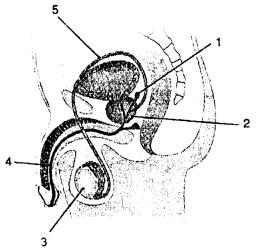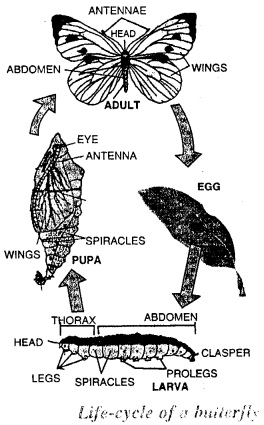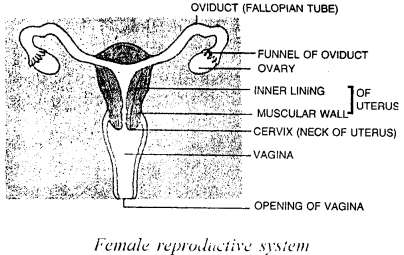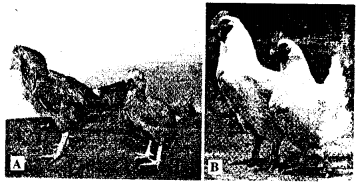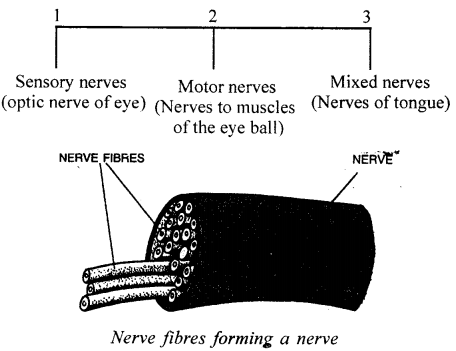Selina Concise Biology Class 8 ICSE Solutions – Transportation in Plants
ICSE SolutionsSelina ICSE SolutionsML Aggarwal Solutions
APlusTopper.com provides step by step solutions for Selina Concise ICSE Solutions for Class 8 Biology Chapter 1 Transportation in Plants. You can download the Selina Concise Biology ICSE Solutions for Class 8 with Free PDF download option. Selina Publishers Concise Biology for Class 8 ICSE Solutions all questions are solved and explained by expert teachers as per ICSE board guidelines.
Selina Class 8 Biology ICSE SolutionsChemistryPhysicsMathsGeographyHistory & Civics
Selina Concise ICSE Solutions for Class 8 Biology Chapter 1 Transportation in Plants
REVIEW QUESTIONS
Multiple Choice Questions:
1. Put a tick mark (✓) against the correct alternative in the following statements:
(a) Diffusion occurs when molecules move:
- from lower concentration to higher concentration.
- from higher concentration to lower concentration through a membrane.
- from higher concentration to lower concentration.
- when energy is used.
Answer: (3) from higher concentration to lower concentration.
(b) Ascent of sap in plants takes place through:
- Cortex
- Epidermis
- Xylem
- Phloem
Answer: (3) Xylem
(c) If the xylem vessels of a plant are plugged:
- The leaves will turn yellow
- No food will be made
- The plant will wilt (shrivel)
- The plant will continue to grow
Answer: (3) The plant will wilt (shrivel)
(d) Force responsible for the ascent of sap is:
- Capillary force
- Root pressure
- Transpirational pull
- All the three
Answer: (4) All the three
(e) Raisins swell when put in:
- Rain water
- Tap water
- Mustard oil
- Saturated sugar solution
Answer: (1) Rain water
(f) The root-hairs are suited for absorbing water from the soil because:
- They have a large surface area
- They have a semi-permeable membrane
- They contain a solution of higher concentration than the surrounding water.
- All the three.
Answer: (4) All the three.
(g) Transpiration is defined as:
- the rise of water up to the stem of a plant.
- the elimination of water with dissolved water products.
- the loss of water as water vapour from the aerial parts of a plant.
- the loss of water as water vapour from the roots as well as the leaves of the plant.
Answer: (3) the loss of water as water vapour from the aerial parts of a plant.
(h) Which one of the following favours the fastest transpiration rate ?
- A cool, humid, windy day,
- A hot, humid, windy day,
- A hot, humid, still day,
- A hot, dry, windy day.
Answer: (4) A hot, dry, windy day.
Short Answer Questions:
Question 1.
An experiment was set up as shown in the figure below. After some time, the Water level in test tube A fell down but not in test tube B.
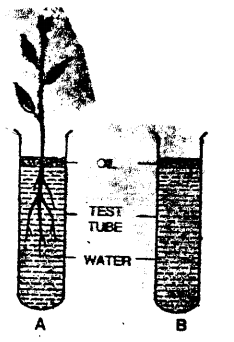
Why was there a fall in the water level of test tube A and not in that of test-tube B ?
Answer:
In test tube A the water level falls because the water was absorbed by the plant through its roots dipped in water. Here no water loss occurs due to evaporation from the water surface due to presence of oil.
In test tube B the water level remains unchanged as it does not contain a rooted plant. Due to the presence of oil on surface no water loss occurs due to evaporation.
Question 2.
How are roots useful to the plants? Give any two points.
Answer:
Roots are useful to the plants in the following way:
- It absorbs water and minerals from the soil and transport it upward to various parts of a plant.
- Roots fix the plant firmly in the ground.
Question 3.
What do xylem vessels carry?
Answer:
The xylem vessels carry the water and minerals absorbed by the roots to the stem and leaves.
Question 4.
Name the plant tissue which helps in carrying the food to different parts.
Answer:
Phloem.
Question 5.
Define the terms:
(a) semi-permeable membrane
(b) osmosis.
Answer:
(a) Semi-permeable membrane: It is a membrane that allows the movement of solvent molecules (e.g. water molecules) through it but prevents the movement of solute particles (e.g. sugar or salt molecules).
For example: Egg membrane, parchment membrane, cellophane paper etc. are semi-permeable membranes.
(b) Osmosis: The diffusion of water molecules through a semi-permeable membrane from a region where water is more concentrated to a region where it is less concentrated is called osmosis.
In other words, osmosis is the diffusion of water from its pure state or dilute solution into a stronger or concentrated solution through a semi-permeable membrane.
Question 6.
Under what conditions do plant transpire (a) more quickly and (b) most slowly?
Answer:
(a) Transpiration is faster on hot summer days as compared to cold winters.
(b) Transpiration is reduced if the air is humid. Air cannot hold any water molecules when it is already laden with moisture (humidity).
Question 7.
Given here is an enlarged diagram of a part of the root. Draw arrows on the diagram to show the movement of water passing through different parts.
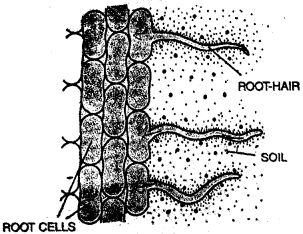
Answer:
Path of water through the root hair to the xylem vessels.
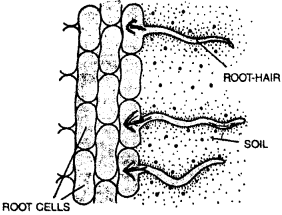
Question 8.
Why is the structure of the root hair is quite suitable for absorbing water from the soil ?
Answer:
The root hair are suitable for absorbing water from the soil in the following three ways:
- The root hairs present a large surface area. More the surface area, greater is absorption.
- The cell wall is of cellulose nature and forms permeable membrane and the plasma membrane around the vacuole forms the semi-permeable membrane.
- Root hairs have solution (cell sap) of a higher concentration than the surrounding soil water.
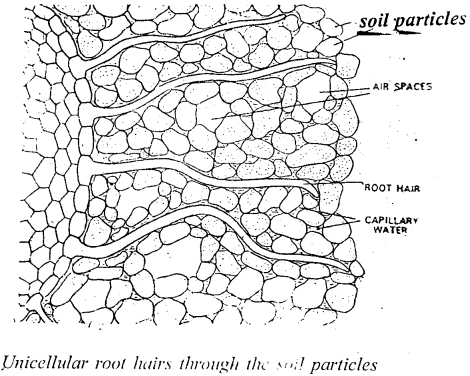
Fig. Unicellular root hairs through the soil particles
Question PQ.
In an experimental set-up, a dye was placed at the bottom of a beaker filled with water as shown in figure A, below. After some time, the entire water in the beaker got coloured uniformly as shown in figure D.

Answer:
(a) Name and define the phenomenon shown in the experiment.
Answer: The phenomenon is diffusion. Diffusion is the movement of the molecules or atoms of a substance (whether in a solid, liquid or gaseous state) from the region of higher concentration to the region of lower concentration.
(b) In all the four figures, two kinds of molecules are shown symbolically – larger and smaller. Which molecules are of the solute and which are of the solvent?
(a) Larger: ………… (b) Smaller: …………..
Answer: (a) The larger molecules are of the solute (dye)
(b) The smaller molecules are of the solvent (water)
(c) If all the dark shaded molecules in A are tightly enclosed in a cell membrane, what will be the nature of movement of the molecules, if any ?
Answer: As the concentration of solvent molecules is more in the left side of the figure A. The cell membrane will act as semi permeable membrane and will allow only the solvent molecules of water to move towards the solute particles. So the solvent molecules will move towards the solute particles. This will show the phenomenon or process of osmosis.
Question 9.
Briefly explain, how transpiration helps in upward conduction of water in plants? (a) ………… (b) ……………
Answer:
(a) Plants continuously absorb water through their roots. This water is sent up through the stem to all parts of the plant, including the leaves. Only a little amount, of water is retained in the plant or utilised by it in photosynthesis. The rest of it gets evaporated into the atmosphere as water vapour through the stomata present in the epidermis of the leaves and other aerial parts of the plant. This creates a suction pressure which pulls up water from xylem of the roots to the stem and then to the leaves.
(b) Xylem tissues are in the form of capillary tubes (tracheids and fibres) where narrower the diameter, greater will be the force. Whenever the xylem vessels lay empty, such as during the loss of water by transpiration, the water from below rises into them by a capillary force.
During day time, water is lost from the surface of the leaves by the process of transpiration. In this process, more and more water molecules are pulled up due to their tendency of rentainingjoined (cohesion). Such pulling force created by the leaves is very important in the case of tall trees where an upward conduction of water takes place.
Question 10.
How does temperature, light intensity and wind affect transpiration?
Answer:
Temperature: Transpiration is faster on hot summer days as compared to cold winters.
Light intensity: The transpiration rate is increased due to the increase in light intensity. During daytime in the sunlight, the rate of transpiration is faster. This is because the stomata remain open to allow the inward diffusion of carbon dioxide for photosynthesis. During dark, the stomata are closed, and hence transpiration hardly occurs at night.
Wind: Transpiration is more when the wind is blowing faster as water evaporates faster from the leaves.
Question 11.
The set up shown alongside was kept in sunlight for an hour. It was observed that drops of water appeared on the inside of the polyethylene bag.
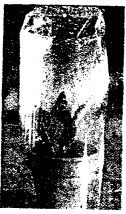
(a) Name the process which is being demonstrated.
(b) Why was the pot and its soil left uncovered by the polythene bag ?
(c) Why was the pot left in the sunlight?
(d) Suppose the pot in this experiment was placed inside a dark room instead of placing it in sunlight for some time. What difference will be noticed?
Answer:
(a) The process demonstrates the loss of water that has appeared in the polythene bag is transpiration.
As the potted plant covered with polythene bag is kept in the sunlight there will be loss of water through the stomata present on the leaves. The water drops will appear inside the polythene bag as a result of loss of water from the stomata. This is due to transpiration.
(b) As the potted plant is kept in the sun. The water vapours will also be given by the pot and the wet soil. These vapours (water drops) will also go inside the polythene if it covers the pot and the soil. We left the pot and soil uncovered by the polythene so that we may find the loss of water from the aerial parts of the plant covered with polythene bag. This shows that the water gets deposited in the polythene bag has come from the aerial parts of plant.
(c) As we keep the pot in the sunlight the stomata will open and the loss of water i.e., transpiration takes place from the aerial parts of the potted plant and the stomata. The loss of water will be more (transpiration) in the sun, and water vapours will appear in the polythene bag very soon.
(d) As we keep the pot inside the room, the stomata will not open fully and the rate of loss of water will be very-very less, and no water vapours will appear in the polythene bag. By keeping the pot in the room the loss of water will be very less and as a result the transpiration will be very less.
Question 12.
State whether the following statements are true or false. Rewrite the false statements correctly.
(a) Water absorption mainly occurs through the root-hair.
True
(b) Water enters the root-hair by osmosis.
True
(c) Water absorbed by the roots reaches the leaves and is used in producing food for the entire plant.
True
(d) A semi-permeable membrane allows larger molecules to pass through, but prevents the smaller ones.
False. A semi-permeable membrane allows smaller molecules to pass through, but prevents the smaller ones.
(e) Transpiration is the loss of water from the roots of the plant.
False. Transpiration is the loss of water from the aerial parts of the plant.
(f) Transpiration cools the plant when it is hot outside.
True
(g) During transpiration, the leaves lose more water from their upper surface.
False. During transpiration, the leaves lose more water from their lower surface.
Question 13.
Fill in the blanks with suitable terms given below: (Fast, Leaves, Stomata, Conducting, Ascent, Humid)
(a) Transportation in plants is carried out by a conducting system.
(b) The upward movement of sap that contains water and minerals is called ascent of sap.
(c) Transpiration is more when the wind is blowing fast.
(d) Most water gets evaporated from the plant from its leaves.
(e) Transpiration is reduced if the air is humid.
(f) The leaves have more stomata on their lower surface.
Long Answer Questions:
Question 1.
Draw a magnified view of the root-hair, and describe, how it helps in the absorption of water from the soil.
Answer:

Give above is a magnified view of a root-hair. It is a long protuberance of a cell. This cell contains a fluid called cell sap which is more concentrated than the surrounding soil water.
The root hair is covered by a very thin ceil membrane that allows water molecules to pass through, but prevents the larger molecules. So the water from the soil passes into the root hairs by osmosis.
Question PQ.
“Raisins swell in water, and grapes shrink in syrup.” Explain this phenomenon briefly.
Answer:
When we put some raisins in a bowl containing water, after 10-12 hours, we will notice that the raisins have swelled up. The raisins have absorbed water.

But when we put some soft-skinned grapes in another bowl containing thick syrup of sugar. After 10-12 hours we will notice that grapes have shrunk. The grapes have lost water.
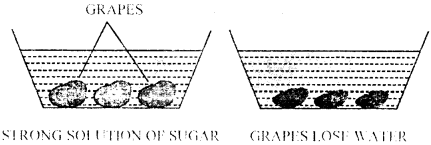
In both cases the gain or loss of water is through the peel acting as a kind of semi-permeable membrane. This membrane has very minute pores which allow water molecules to pass through, but prevent the larger ones of sugar.
Question 2.
How does transpiration help the roots absorb water and minerals from the soil?
Answer:
Transpiration process in plants creates a suction pressure which pulls up water from xylem of the roots to the stem and then to the leaves.
Xylem tissues are in the form of capillary tubes (tracheids and fibres) where narrower the diameter, greater will be the force. Whenever the xylem vessels lay empty, such as during the loss of water by transpiration, the water from below rises into them by a capillary force.
Due to transpirational pull more and more water molecules are pulled up due to their tendency of remaining joined (cohesion). Such pulling force created by the leaves is very important in the case of tall trees where an upward conduction of water takes place.
Question 3.
Define the three processes by which plants absorb water and minerals from the soil.
Answer:
Following are the tree processes which help the plants to absorb water and minerals from the soil.
- Diffusion: Soil water moves into the root hairs through the process of diffusion from higher concentration to lower concentration as we put sugar in the milk and the sugar molecules are evenly distributed in the milk and occupy inter molecular spaces of milk.
- Osmosis: The cell sap and the cell walls act as semi- permeable membranes and permeable membranes. The concentration of the cell sap is more as compared to the water + minerals present in the soil. So the water and dissolved minerals enters the roots by the process of osmosis.
- Active transport: Root hairs absorb water and minerals from the soil. Water diffuses into the root hairs as the concentration of water is more as compared to root hair.
But in case of minerals these move from lower concentration to molecules of higher concentration. So the minerals from the soil along with water move into the roots. So this is active transport in the opposite direction which needs energy.
Question 4.
How water absorbed by the roots is important for the plants?
Answer:
The water absorbed by the roots is important for the plant in three main ways:
- Transportation: The water in the plant body transports substances in solution from one part to another.
- Food production: Water is used in producing food (photosynthesis) by combining it with carbon-dioxide from the air in the presence of sunlight.
- Cooling: Water is used to cool the plant by evaporation through leaves when it is hot outside.
Question 5.
Name the factors which affect the rate of transpiration? State their role in each case.
Answer:
The following are the main factors that affect the rate of transpiration:
- Sunlight: During daytime, the rate of transpiration is faster. This is because the stomata remain open to allow the inward diffusion ofcarbondioxide for photosynthesis.
During dark, the stomata are closed, and hence transpiration hardly occurs at night. - Temperature: Transpiration is faster on hot summer days as compared to cold winter.
- Wind: Transpiration is more when the wind is blowing faster as water evaporates faster from the leaves.
- Humidity: Transpiration is reduced if the air is humid. Air cannot hold any water molecules when it is already laden with moisture (humidity).
- Low atmospheric pressure: The rate of transpiration increases when the pressure is low.
Question 6.
Mention the two ways in which transpiration helps the plants.
Answer:
Transpiration helps the plants in the following ways:
- Cooling effect: In transpiration, water gets evaporated from the plant. The heat required for this evaporation is obtained from the plant itself (latent heat) and thus the plant is able to cool itself w’hen it is hot outside.
- Transpiration helps in maintaining the concentration of the sap inside the plant body: The roots continue to absorb water from the soil. If excess water is not evaporated out, the sap would become dilute, preventing further absorption of water along with the minerals required by the plant.
Question 7.
Describe an experiment to show that the plant loses water through its leaves.
Answer:
Experiment: To demonstrate that the plants lose water through its leaves.
- Take one small-sized, well-watered potted plant having a few branches. Place a polythene bag over its one branch as shown in A and tie it with a rubber band.
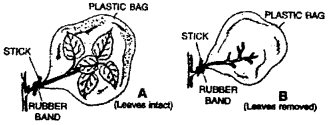
- Remove all the leaves from another branch (B) of the same plant, cover this too with a polythene bag and tie it with a rubber band.
- Place the plant in sunlight, and observe it after 4-6 hours. You will notice that drops have appeared on the inner surface of the polythene bag over branch A, while no water drops appear on branch B.
- This set-up indicates that most water gets evaporated from the plant through its leaves.
Question 8.
Name any three minerals whose deficiency causes diseases in plants. Give the symptoms of each deficiency.
Answer:
The nutrient elements i.e. minerals are essential for the plants to grow well and complete their life-cycle properly. The minerals are divided into two main categories:
(i) Macro-Nutrients: They are required in larger concentrations and they are obtained from soil.
The three macro-nutrients (minerals) whose deficiency causes diseases in plants are:
- Nitrogen (N) – Yellowing of leaves,wrinkling of cereal grains.
- Phosphorus (P) – Purple and red spots on leaves, delay in seed germination.
- Potassium (K) – Poor Growth
(ii) Micro Nutrients: They are required in small amounts and they are also obtained from soil.
The three micro-nutrients(minerals) whose deficiency causes diseases in plants are:
- Iron (Fe) – Yellowing of Leaves.
- Manganese (Mn) – Yellowing of leaves, with grey spots.
- Zinc (Zn) Desphaped leaves, yellowing of leaves, stunted plant growth.
Question 9.
List out the differences between xylem and phloem.
Answer:
The Xylem tissue consists of four types of cells:
- Tracheids: They are elongated dead cells with tapering ends. Their main function is in upward conduction of water and provide mechanical support.
- Vessels: They are like tube-like structures placed one above the other forming long channels. They provide mechanical support and also transport water and mineral salts laterally and vertically upward.
- Fibres: They are long, narrow and tapering at both ends. They provide only mechanical support.
- Parenchyma: They are living cells and helps in the conduction of water and minerals, and serve for the storage of food.
The Phloem tissue consists of four types of cells:
- Seive tubes: They are formed of seive cells and form the main conducting part of the phloem. These are cylindrical cells arranged in vertical rows, joined end to end. Their end walls are perforated by pores and are called seive plates. Seive piates helps in passing food material from cell to cell.
- Companion Cells: They are associated with seive tubes. It help sieve tubes in the conduction of food material.
- Parenchyma: It is formed of thin-walled unspecialized parenchymatous cells and these cells store food.
- Phloem fibres: They are dead sclerenchyma fibres formed of elongated cells. These provide mechanical strength.

